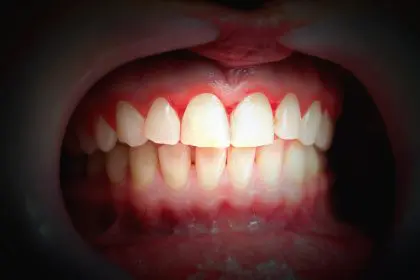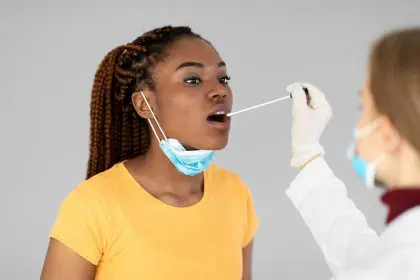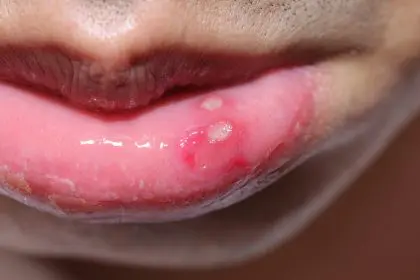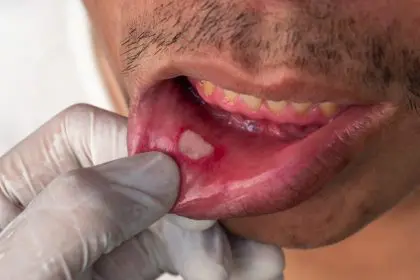Those small, painful bumps that suddenly appear on your tongue can transform eating, drinking, and even speaking into uncomfortable challenges. Tongue blisters, while typically not serious, create significant discomfort in daily activities most people take for granted. Understanding the various causes of these painful lesions helps identify appropriate treatments and preventive measures, potentially reducing both their frequency and duration. While most tongue blisters resolve within a week or two without serious complications, recognizing when they might indicate more significant health concerns allows for appropriate medical attention when necessary.
Canker sores: The most common culprit
Canker sores (aphthous ulcers) represent the most frequent cause of painful tongue blisters, affecting approximately 20% of the population with recurring episodes. These distinctive lesions have specific characteristics and triggers that distinguish them from other mouth sores.
The typical appearance of canker sores includes a round or oval shape with a white or yellowish center surrounded by a red, inflamed border. These painful ulcers range from tiny (minor aphthous ulcers measuring 3-10mm) to quite large (major aphthous ulcers exceeding 10mm). When affecting the tongue, they most commonly appear on the tip, sides, or underside, though they can develop anywhere on the oral mucosa. Unlike some other mouth sores, canker sores remain confined to the soft tissues and never develop on the gums or roof of the mouth where tissue attaches firmly to underlying bone.
Minor injury to the tongue frequently triggers these lesions. Accidentally biting your tongue, brushing too vigorously, or scraping against dental appliances like braces or rough tooth edges can create small tissue injuries that develop into canker sores within 24-48 hours of the initial trauma. Even seemingly minor injuries can initiate the inflammatory cascade leading to these painful ulcers.
Certain foods show strong associations with canker sore development in susceptible individuals. Acidic foods like tomatoes, pineapple, strawberries, and citrus fruits commonly trigger episodes. Other potential dietary triggers include chocolate, coffee, nuts, and spicy foods. Food sensitivities rarely cause systemic allergic reactions but instead create localized inflammation leading to canker sore formation in predisposed individuals.
Nutritional deficiencies correlate strongly with increased canker sore frequency and severity. Low levels of vitamin B12, zinc, folate, or iron create favorable conditions for these lesions to develop, with supplementation often reducing occurrence in deficient individuals. The relationship appears particularly strong with B12 deficiency, where canker sores sometimes provide the first noticeable symptom before other deficiency signs emerge.
Hormonal fluctuations explain why many women experience canker sores during specific phases of their menstrual cycle. The changing hormone levels, particularly during the luteal phase (days 14-28), create conditions favorable for these lesions to develop. Similar patterns often emerge during perimenopause when hormone fluctuations become more pronounced.
Stress and immune factors play significant roles in canker sore development. Psychological stress compromises immune function and increases inflammatory markers, creating conditions where canker sores develop more readily. This relationship explains the common observation that these lesions often appear during periods of high stress like examinations, major life changes, or work pressure.
While canker sores typically heal within 10-14 days without treatment, various interventions can reduce discomfort and potentially accelerate healing. Topical pain relievers containing benzocaine provide temporary comfort, while protective pastes form barriers over the sores to shield them during eating and drinking. Antimicrobial mouth rinses may reduce healing time by preventing secondary infection of the exposed tissue. For severe or frequently recurring cases, prescription options include topical steroids or systemic medications that moderate the immune response.
The distinction between canker sores and other mouth lesions remains important for proper treatment. Unlike cold sores, canker sores are not contagious, do not form blisters before ulcerating, and never appear on the outer lips or facial skin. This non-contagious nature means no special precautions regarding sharing utensils or kissing are necessary, unlike with viral lesions.
Thermal burns: Heat-related injuries
The tongue’s vulnerability to heat-related injuries stems from its highly vascularized tissue and its role in food evaluation before swallowing. These thermal burns create distinctive blisters with specific progression patterns that differ from other tongue lesions.
The initial contact injury occurs when hot food or beverages touch the tongue surface. Items like pizza, melted cheese, hot coffee, or freshly microwaved foods present particular risks due to their ability to trap heat. The tongue’s abundant pain receptors immediately signal discomfort, but often too late to prevent injury, as the contact typically occurs during the initial taste evaluation. This sampling function, designed to protect the digestive tract from harmful substances, ironically makes the tongue especially vulnerable to thermal damage.
Burn severity classification follows similar patterns to skin burns but with modifications for the oral environment. First-degree burns affect only the outermost layer of tongue tissue, creating pain and redness without blister formation. Second-degree burns extend deeper, damaging blood vessels that leak fluid, forming the characteristic blisters. Third-degree burns, fortunately rare in the mouth, destroy tissue through all layers, potentially affecting nerve endings and creating long-term sensory or functional issues.
The blister formation process begins immediately after significant thermal injury. The heat damages cell membranes, allowing fluid to leak from blood vessels into the space between tissue layers. This fluid accumulation creates the raised, fluid-filled blister typically appearing within hours of the initial burn. Unlike canker sores that form open ulcers from the beginning, thermal burn blisters initially remain intact before potentially rupturing during eating or tongue movement.
The healing progression follows a typical pattern in uncomplicated cases. The initial pain peaks during the first 24 hours, gradually diminishing over the following days. If the blister remains intact, the underlying tissue heals more comfortably as the fluid provides a protective cushion. When blisters rupture, the exposed tissue creates temporary increased pain and sensitivity until new epithelial cells grow to cover the area, typically within 7-10 days for moderate burns.
Treatment approaches focus on pain management and preventing infection in the damaged tissue. Cold liquids immediately after the burn may limit damage depth by reducing tissue temperature. Avoiding further irritation from spicy, acidic, or rough foods allows undisturbed healing. Over-the-counter pain relievers provide temporary comfort, while antimicrobial mouth rinses help prevent secondary infection that could complicate healing. Unlike thermal burns on skin, special burn creams generally aren’t recommended for tongue injuries due to frequent washing away and potential ingestion.
Distinguishing thermal burns from other tongue lesions relies on the clear history of hot food contact and the distinctive appearance. The raised blister with relatively normal-appearing surrounding tissue differs from the ulcerated depression with inflamed borders typical of canker sores. Additionally, thermal burns typically affect the tongue’s forward portions that first contact food, while other conditions may appear in various locations regardless of food contact areas.
Medical attention becomes warranted for severe burns showing extensive tissue damage, burns causing difficulty with eating or drinking for more than a few days, or burns showing signs of secondary infection like increasing pain after initial improvement or pus formation. While most thermal tongue burns heal without complications, these situations may benefit from professional evaluation and treatment to prevent long-term consequences.
Viral infections: Herpes and others
Several viral infections can manifest as blisters or sores on the tongue, with herpes simplex virus being the most common culprit. These infections create distinctive lesion patterns and progression that help distinguish them from non-infectious causes.
Herpes simplex virus type 1 (HSV-1) infections frequently affect the mouth, with the tongue serving as one possible location. The virus typically enters the body during childhood through contact with an infected person’s saliva or active lesions. After the initial infection, the virus establishes lifelong residence in nerve ganglia, periodically reactivating to cause recurrent lesions. While most people associate herpes with lip sores (cold sores), the virus can cause identical lesions on the tongue during either initial infection or recurrences.
The characteristic progression of herpes lesions begins with a prodromal (pre-eruption) phase marked by tingling, burning, or itching in the affected area, typically occurring 1-2 days before visible changes. Small clusters of fluid-filled blisters then erupt, often merging to form larger lesions. These blisters quickly rupture, creating painful ulcerations with irregular borders. The entire cycle from prodrome to complete healing typically spans 10-14 days in immunocompetent individuals.
Viral transmission occurs through direct contact with active lesions or infected saliva. This contagious nature distinguishes herpes lesions from canker sores or thermal burns, which cannot spread to others. The highest transmission risk occurs during the blister and ulcer phases, though viral shedding can occur even without visible lesions in some individuals. This transmission potential makes awareness particularly important for preventing spread to others, especially newborns, who can develop severe systemic infections if exposed.
Triggering factors for recurrent herpes outbreaks include ultraviolet light exposure (sunlight), fever or other infections, hormonal fluctuations, physical or emotional stress, and immune system suppression. Many patients recognize their personal triggers and can predict outbreaks based on specific exposures. This predictability sometimes allows preventive treatment before lesions fully develop.
Treatment approaches include both prescription and over-the-counter options. Antiviral medications like acyclovir, valacyclovir, or famciclovir can reduce outbreak duration and severity when started during the prodromal phase or within 72 hours of blister appearance. These medications work by inhibiting viral replication, allowing the immune system to control the infection more effectively. For frequent recurrences, daily suppressive therapy with these medications can reduce outbreak frequency. Over-the-counter products containing docosanol may modestly reduce healing time when applied at the first symptom.
Other viral causes of tongue blisters include coxsackievirus (hand, foot, and mouth disease) primarily affecting children, varicella-zoster virus (chickenpox or shingles) rarely affecting the mouth, and Epstein-Barr virus sometimes causing oral lesions during infectious mononucleosis. Each creates somewhat distinctive patterns that help with identification—coxsackievirus typically causes multiple small blisters throughout the mouth alongside skin lesions, while varicella-zoster follows nerve distributions with intense pain often preceding the visible lesions.
Distinguishing viral lesions from other tongue blisters involves noting several key features: the clustering pattern of multiple small blisters rather than isolated lesions; the presence of similar lesions elsewhere in the mouth or on the lips; the recurrent nature at the same location; and the distinctive tingling prodrome before visible changes. These characteristics, particularly when combined with a history of previous similar episodes, strongly suggest viral origin rather than other causes.
Allergic and sensitivity reactions
The tongue’s extensive exposure to potential allergens and irritants makes it susceptible to various reaction-related blisters and swelling. These reactions range from mild, localized responses to potentially serious systemic allergies requiring immediate medical attention.
Contact reactions on the tongue typically develop after direct exposure to triggering substances. Common culprits include certain toothpaste ingredients (particularly sodium lauryl sulfate and cinnamon flavoring), mouthwashes containing alcohol or essential oils, dental materials like metals in fillings or dentures, and food additives including artificial colors, flavors, or preservatives. These reactions create localized inflammation, sometimes with small blisters or swelling, confined to areas directly contacting the triggering substance.
True allergic reactions follow different mechanisms than simple irritation. When the immune system identifies a substance as potentially harmful, it produces antibodies specific to that allergen. Upon re-exposure, these antibodies trigger inflammatory cascades involving histamine release and other immune mediators. On the tongue, this process can create rapid swelling, multiple small blisters, or a burning sensation disproportionate to any actual tissue damage. Common food allergens including nuts, shellfish, eggs, and certain fruits frequently trigger these responses.
Oral allergy syndrome represents a specific cross-reactivity phenomenon where individuals allergic to certain pollens react to related proteins in fresh fruits and vegetables. For example, those with birch pollen allergies often react to apples, cherries, peaches, and various raw vegetables. These reactions typically cause immediate itching, tingling, or small blisters confined to the mouth and tongue, without progressing to systemic symptoms. Interestingly, the same foods often cause no reaction when cooked, as the heating process denatures the proteins responsible for the cross-reactivity.
Medication reactions sometimes manifest primarily or initially in the mouth. Antibiotics (particularly sulfa drugs), non-steroidal anti-inflammatory drugs, and certain blood pressure medications commonly create oral reactions including tongue blisters or swelling. These reactions can develop even after previously tolerating the medication for extended periods, as sensitization sometimes occurs gradually over time rather than upon initial exposure.
Distinguishing features of allergic or sensitivity reactions include their timing relationship to exposure, often developing within minutes to hours after contact with the triggering substance. The distribution of lesions typically corresponds to contact areas rather than following patterns characteristic of viral or autoimmune conditions. Additionally, completely avoiding the trigger usually prevents recurrence, unlike conditions with internal triggering mechanisms that recur despite avoidance measures.
Potential severity varies dramatically among reaction types. Simple irritant contact reactions typically remain localized and resolve without serious complications. True allergic responses can range from mild, mouth-limited symptoms to severe systemic reactions including anaphylaxis, where tongue and throat swelling can compromise breathing. This variation necessitates taking all oral allergic symptoms seriously, particularly when they develop rapidly or continue worsening after initial onset.
Diagnosis typically involves carefully documenting exposure patterns and reaction timing. In cases where the trigger remains unclear, allergists may perform patch testing or blood tests measuring specific antibodies to potential allergens. For suspected food triggers, elimination diets followed by careful reintroduction can help identify culprits when more direct testing proves inconclusive.
Management strategies begin with identifying and avoiding triggers whenever possible. For unavoidable exposures or uncertain triggers, antihistamines often reduce reaction severity when taken preventively. Topical steroids may help manage localized reactions, while severe reactions sometimes require systemic steroids or injectable epinephrine in emergency situations. Those with histories of serious reactions typically carry emergency medication and should wear medical alert identification indicating their specific allergies.
Chemical irritation: Products and substances
Various chemicals in everyday products can create tongue irritation and blisters through direct tissue damage or sensitivity reactions. Understanding these potential irritants helps identify and avoid substances that may trigger painful oral lesions.
Alcohol-containing products frequently cause oral irritation, particularly when used at high concentrations or for extended periods. Mouthwashes containing alcohol percentages exceeding 15% can dehydrate and damage the tongue’s epithelial cells, creating small cracks that may develop into painful lesions. This irritation increases in individuals with dry mouth conditions (xerostomia), as reduced saliva provides less protective dilution and buffering. Even alcoholic beverages themselves can sometimes irritate the tongue, especially higher-proof spirits consumed undiluted.
Oxidizing agents in oral care products sometimes trigger tongue reactions. Hydrogen peroxide, carbamide peroxide, and sodium percarbonate found in whitening toothpastes, strips, or rinses can cause chemical burns or irritation when contacting tongue tissue. These chemicals, while effective for their intended purposes, work through oxidative processes that don’t distinguish between stain molecules and normal tissue components, potentially damaging both when used improperly or excessively.
Acidic substances represent common tongue irritants, whether from dietary sources or medications. Chewable vitamin C tablets, acidic candies, citrus fruits consumed in quantity, or beverages with pH below 4.0 can all create direct chemical irritation, particularly when held against the tongue rather than quickly swallowed. Similarly, aspirin tablets held against painful teeth or gums (a common home remedy) create localized acid burns that may develop into blisters or ulcers if the practice continues.
Essential oils and flavoring agents, particularly cinnamon derivatives, rank among the most common tongue irritants in commercial products. These compounds, while natural in origin, can trigger both irritant and allergic reactions when contacting oral tissues. Cinnamon-flavored products (candies, gums, toothpastes, or mouthwashes) frequently cause reactions even in individuals who tolerate dietary cinnamon without problems, as the concentrated extracts used in these products contain higher levels of the reactive compounds than typical food preparations.
Preservatives and foaming agents in oral products occasionally trigger tongue blisters in sensitive individuals. Sodium lauryl sulfate (SLS), the most common foaming agent in toothpastes, dissolves the protective mucin layer covering the tongue, potentially allowing irritants greater tissue access. Parabens and sodium benzoate used as preservatives sometimes create sensitivity reactions that manifest as tongue irritation, swelling, or blistering in susceptible individuals.
The pattern of irritant reactions typically follows product contact areas rather than appearing randomly across the tongue. Toothpaste reactions often affect the tongue tip and sides, where brushing contact occurs most frequently. Mouthwash reactions usually appear more diffusely across the entire tongue surface. Food additive reactions frequently manifest where the substance rests during chewing, typically on the central forward portion of the tongue.
Diagnosis relies heavily on the relationship between exposure timing and symptom development. Eliminating suspected products for 10-14 days, followed by careful reintroduction, often identifies the culprit. When multiple potential irritants exist, systematically eliminating one product category at a time while maintaining detailed symptom records helps narrow possibilities. Professional patch testing sometimes assists diagnosis for complex or severe cases where self-directed elimination proves inconclusive.
Prevention focuses on identifying and avoiding trigger substances once identified. For necessary products like toothpaste, alternative formulations without common irritants are increasingly available. Natural options without artificial flavors, preservatives, foaming agents, or alcohol provide alternatives for sensitive individuals, though ensuring adequate fluoride content remains important for dental health. Reading ingredient lists carefully and being particularly cautious with new products helps prevent unexpected reactions.
Traumatic injuries beyond burns
The tongue’s mobility and position make it vulnerable to various mechanical injuries beyond thermal burns. These traumatic injuries create distinctive blisters and sores with specific characteristics related to their causative mechanisms.
Bite injuries represent the most common traumatic cause of tongue blisters. The tongue’s mobility during speaking, eating, or sleeping sometimes places it between the teeth during biting or chewing motions. The resulting injury creates distinctive patterns with deep indentations matching dental anatomy, often with bilateral punctures or linear tears reflecting the biting surfaces. These injuries frequently occur during seizures, when sedated, after dental anesthesia while sensation remains diminished, or simply from momentary inattention during eating.
Sharp food injuries occur when rigid, pointed food items directly puncture or lacerate tongue tissue. Common culprits include tortilla chips, hard pretzel edges, fish bones, poultry bones, or wooden skewers in prepared foods. These injuries typically create small, discrete punctures or lacerations that may develop into painful blisters during the healing process as tissue fluids accumulate at the injury site. The initial injury often feels disproportionately painful relative to its size due to the tongue’s abundant nerve supply.
Dental appliance trauma commonly causes tongue lesions, particularly when appliances are new or damaged. Orthodontic braces with protruding wires, rough edges on fillings or crowns, broken dental restorations with sharp margins, or ill-fitting dentures frequently create recurring injuries to the same tongue areas. These repeated minor traumas prevent complete healing, sometimes leading to persistent sores or defensive callus formation at frequently injured sites.
Oral habits sometimes create self-inflicted tongue injuries. Tongue thrusting against teeth, chewing or sucking on the tongue, repeatedly touching damaged areas, or running the tongue against rough tooth surfaces can create chronic irritation leading to blister formation. These behaviors often occur unconsciously, particularly during concentration or stress, making identification and modification challenging without deliberate attention.
The healing pattern of traumatic tongue injuries differs somewhat from other blister causes. The tongue’s excellent blood supply promotes rapid healing, with most minor traumatic injuries resolving within 3-7 days barring complications or continued irritation. However, this same vascularity creates pronounced swelling immediately following injuries, sometimes causing alarm disproportionate to the actual damage extent. The moist oral environment both helps and hinders healing—providing necessary hydration but also harboring bacteria that may cause secondary infection if injuries are substantial.
Treatment approaches focus on preventing further trauma while supporting the natural healing process. Avoiding rough, spicy, or acidic foods reduces irritation to damaged areas. Careful oral hygiene prevents secondary infection without disrupting healing tissue. Protective measures like dental wax over sharp appliance edges prevent recurring trauma to the same areas. For larger lacerations, professional evaluation determines whether suturing might be beneficial, though many tongue injuries heal remarkably well without intervention due to the tissue’s regenerative capacity.
Distinguishing traumatic injuries from other tongue lesions typically relies on identifying the mechanical cause and noting the injury’s correspondence to potential sources of trauma. The recent installation of dental work, changes in oral habits, or consumption of potentially injurious foods all provide important diagnostic clues when combined with the lesion’s appearance and location. Unlike recurrent conditions like aphthous ulcers or herpes, traumatic injuries resolve without recurrence once the causative factor is addressed and healing completes.
Medical attention becomes warranted for traumatic tongue injuries when bleeding proves difficult to control, when injuries appear deep enough to potentially affect muscle function, when embedded foreign objects cannot be easily removed, or when injuries show signs of infection like increasing pain after initial improvement or pus formation. These situations may require professional cleaning, closure, antibiotic therapy, or removal of foreign material to ensure proper healing.
Mucocele and specialized blisters
Certain specialized fluid collections create distinctive tongue blisters with unique characteristics and causes. Understanding these specific entities helps distinguish them from more common blister types and guides appropriate management.
Mucoceles represent the most common specialized tongue blisters, forming when minor salivary gland ducts become damaged or blocked. Unlike the major salivary glands (parotid, submandibular, and sublingual) that have large ducts opening into the mouth, hundreds of minor salivary glands distribute throughout the oral mucosa, including the tongue. When these tiny glands’ ducts suffer trauma or blockage, saliva leaks into surrounding tissues, creating fluid-filled cavities. These lesions typically appear as painless, soft, slightly bluish, dome-shaped swellings ranging from a few millimeters to over a centimeter in diameter.
The ventral (underside) surface of the tongue hosts most lingual mucoceles due to its abundant minor salivary glands and vulnerability to trauma against lower teeth. These lesions typically develop after minor injuries like accidental biting or food trauma that damages the delicate duct structures. Unlike painful blisters from other causes, mucoceles usually create minimal discomfort unless secondarily injured, instead producing primarily aesthetic concerns or functional interference with speech or swallowing when large.
Ranulas represent specialized mucoceles arising from the sublingual major salivary gland rather than minor glands. These larger lesions appear beneath the tongue, creating more significant swelling that may displace the tongue upward. The term “ranula” derives from the Latin word for “little frog,” reflecting these lesions’ resemblance to a frog’s translucent underbelly. While technically not tongue blisters, ranulas often affect tongue position and function enough to prompt patients to describe them as tongue problems rather than floor-of-mouth conditions.
Lymphoepithelial cysts occasionally develop on the tongue’s posterior portion, particularly around lymphoid tissue aggregates (lingual tonsils). These specialized cysts contain clear or whitish fluid and create painless, smooth-surfaced bumps typically measuring 3-6mm in diameter. Unlike mucoceles resulting from salivary gland disruption, these cysts develop from epithelial cells trapped within lymphoid tissue, gradually expanding as cellular debris accumulates within the cyst cavity. Their posterior location often makes them asymptomatic until they reach sizes that interfere with swallowing or speech.
The natural history of these specialized blisters varies considerably. Small mucoceles frequently rupture spontaneously within weeks of formation, releasing their contents before recollapsing. However, approximately 30% reform repeatedly due to persistent duct damage, requiring intervention for resolution. Ranulas and lymphoepithelial cysts typically persist indefinitely without treatment, gradually enlarging until functional impairment necessitates intervention. Some smaller lesions remain stable indefinitely without causing significant problems, requiring only monitoring rather than active treatment.
Treatment approaches depend on lesion type, size, and associated symptoms. Small, asymptomatic mucoceles often warrant observation, as many resolve spontaneously or remain small enough to cause minimal problems. Larger or persistent mucoceles typically require surgical removal of both the cyst and associated damaged gland to prevent recurrence. Ranulas necessitate more extensive procedures addressing the sublingual gland, while lymphoepithelial cysts respond well to simple excision. Alternative techniques including laser ablation, cryotherapy, or micromarsupialization (creating a new permanent opening from the cyst) sometimes provide less invasive options for appropriate cases.
Distinguishing these specialized blisters from other tongue lesions involves noting their characteristic appearance, minimal pain despite sometimes significant size, fluctuant (fluid-filled) consistency, and typical locations. The soft, compressible nature of these fluid-filled lesions differs from the firmer consistency of solid growths like fibromas or papillomas that might otherwise appear somewhat similar. Their consistent blue or translucent appearance also helps differentiate them from traumatic blisters or inflammatory conditions that typically show more pronounced redness in surrounding tissues.
When to seek medical attention
While most tongue blisters resolve without complications, certain situations warrant professional evaluation due to potential seriousness or need for specific treatments beyond self-care approaches.
Persistent lesions lasting beyond expected healing timeframes represent one of the most important reasons to seek evaluation. Most common tongue blisters from trauma, minor burns, or canker sores should show significant improvement within 7-10 days and complete resolution within two weeks. Lesions persisting beyond 2-3 weeks without improvement deserve professional assessment to rule out more concerning causes or complications preventing normal healing.
Pain severity disproportionate to visible changes or pain that prevents normal eating, drinking, or speaking warrants medical attention. While most tongue blisters cause discomfort, pain severe enough to prevent normal functions or requiring strong analgesics suggests either unusual severity or potential complications like secondary infection. Severe pain may also indicate conditions beyond typical blisters, such as neurological pain syndromes sometimes mistaken for tissue lesions.
Spreading inflammation beyond the initial lesion site potentially indicates infection complicating the original blister. Signs include increasing redness extending to previously uninvolved areas, swelling progressing beyond the immediate lesion boundaries, warmth in surrounding tissues, or pus formation within or around the original blister. These changes suggest bacterial involvement that may require specific antimicrobial treatment rather than just supportive care.
Systemic symptoms accompanying tongue blisters require prompt evaluation. Fever, enlarged lymph nodes in the neck, general malaise, or unusual fatigue developing alongside oral lesions suggest potential systemic involvement rather than localized issues. These symptoms may indicate more extensive infections, systemic viral conditions, or occasionally autoimmune disorders that present initially with oral manifestations before affecting other body systems.
Recurrent episodes without clear triggering factors deserve professional assessment, particularly when occurring with increasing frequency or severity. While some conditions like aphthous ulcers naturally recur, changing patterns or escalating symptoms might indicate underlying health issues contributing to the recurrences. Nutritional deficiencies, undiagnosed gastrointestinal disorders, or immune system abnormalities sometimes manifest primarily through recurrent oral lesions before other symptoms become apparent.
Unusual appearance compared to typical blisters warrants evaluation, particularly for asymmetric, irregularly bordered, or variegated lesions. While most benign blisters have relatively symmetric, rounded shapes with uniform coloration, certain more concerning conditions including oral cancers can occasionally mimic simple blisters during early stages. Professional assessment provides reassurance for benign conditions while ensuring prompt treatment for more serious issues.
Multiple simultaneous lesions throughout the mouth or extending beyond oral tissues raise concerns about systemic conditions rather than localized issues. Various autoimmune conditions (including pemphigus, lichen planus, or erythema multiforme), drug reactions, or widespread viral infections can present with multiple oral lesions. These conditions typically require specific diagnosis and targeted treatments beyond simple supportive care appropriate for isolated blisters.
Immunocompromised individuals should maintain a lower threshold for seeking evaluation for any oral lesions. Those with conditions affecting immune function (including HIV/AIDS, diabetes, or those taking immunosuppressive medications) face higher risks from conditions that remain minor nuisances in otherwise healthy individuals. Infections develop more readily and progress more rapidly in immunocompromised patients, making early intervention particularly important for preventing complications.
These guidelines help distinguish between tongue blisters appropriate for self-care and those warranting professional evaluation. When uncertainty exists, consultation with healthcare providers allows appropriate assessment and guidance tailored to individual circumstances and medical history.
Tongue blisters, while typically benign and self-limiting, can significantly impact quality of life through pain and functional limitations. Understanding their common causes—including canker sores, thermal burns, viral infections, allergic reactions, chemical irritation, traumatic injuries, and specialized fluid collections—helps identify appropriate treatment approaches and preventive strategies.
Most tongue blisters resolve within 1-2 weeks with supportive care including avoiding irritating foods and beverages, maintaining good oral hygiene without disturbing healing tissues, and using topical pain relievers when necessary for comfort. However, certain warning signs including persistence beyond expected healing timeframes, unusual appearance, spreading inflammation, or accompanying systemic symptoms warrant professional evaluation to rule out more concerning conditions.
For recurrent tongue blisters, identifying and addressing underlying triggers—whether dietary sensitivities, mechanical irritants, stress factors, or nutritional deficiencies—can significantly reduce episode frequency and severity. This preventive approach often proves more effective than merely treating each occurrence as it develops.
By recognizing patterns specific to different blister types and responding appropriately, most people can effectively manage these uncomfortable but typically temporary oral health challenges while knowing when professional guidance becomes necessary for optimal outcomes.












